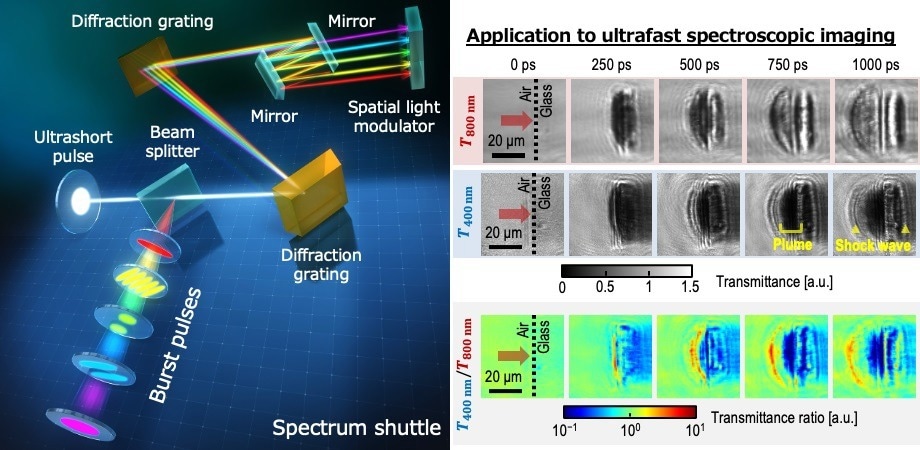High-repetition pulse production and manipulation have enormous potential for several uses, such as high-speed laser processing, acoustic wave generation, and photography. With intervals between ~0.01 and ~10 nanoseconds, gigahertz (GHz) burst pulses are extremely helpful for enhancing laser processing efficiency and observing ultrafast events.

The proposed “spectrum shuttle” method produces gigahertz (GHz) burst pulses from an ultrashort pulse, with each pulse having a different wavelength and a customizable spatial profile. These GHz burst pulses open pathways to a multitude of optical applications, including ultrafast imaging in the GHz range and high-quality and high-throughput laser processing with bursts of ultrashort laser pulses. Image Credit: K. Nakagawa (University of Tokyo)
Although there are techniques for creating GHz burst pulses, there are still issues to be resolved, including limited pulse energy throughput, poor pulse interval tunability, and the complexity of current systems. Moreover, limited spatial light modulator responsiveness makes it difficult to shape the spatial profile of each GHz burst pulse.
In response to these difficulties, a research group at Saitama University and the University of Tokyo has created a novel optical method called “spectrum shuttle,” which permits the simultaneous generation of GHz burst pulses and the individual modification of their spatial characteristics.
Using parallel mirrors to spatially separate the ultrashort pulse into multiple wavelengths, the process entails distributing the pulse horizontally across diffraction gratings. Using a spatial light modulator, each of these vertically aligned pulses is individually spatially modulated. The resultant modulated pulses produce spectrally separated GHz burst pulses, each with a distinct spatial profile and varying temporal delays in the GHz range.
The suggested technique effectively generated GHz burst pulses with individually adjustable wavelengths and temporal intervals, as described in the Gold Open Access journal Advanced Photonics Nexus. It illustrated how spatial profiles are shaped, including peak splitting and location alterations. The method’s capacity to concurrently capture dynamics across multiple wavelength bands was demonstrated by its application in ultrafast spectroscopic imaging.
The technique enables subnanosecond to nanosecond timeframe ultrafast imaging, which makes it possible to analyze fast, non-repetitive processes. The possible uses include monitoring quick physical processes in industrial settings and unearthing undiscovered ultrafast phenomena. The individual shaping of GHz burst pulses has potential applications in laser treatment and precision laser processing.
The suggested method’s small size significantly improves its mobility, which allows it to be used in both scientific research centers and other industrial technology sectors.
Our unique optical configuration allows for the manipulation of ultrashort pulses with a three-dimensional optical path, enabling unprecedented spatial manipulation of GHz burst pulses. Spectrum shuttle offers a wide range of GHz burst pulses with intervals ranging from 10 picoseconds to 10 nanoseconds. I believe that applications based on our technique, aimed at various targets such as plasmas, metals, and cells, will accelerate scientific discoveries and technological innovations in industry and medicine.
Keitaro Shimada, Ph.D. Candidate, Department of Bioengineering, University of Tokyo
With ramifications for both scientific study and industrial applications, the novel approach offers options for the advancement of ultrafast imaging. Its ability to generate and shape GHz burst pulses concurrently offers a flexible tool for researching fast-moving phenomena and optimizing laser-based operations.
Journal Reference
Shimada, K., et. al. (2023) Spectrum shuttle for producing spatially shapable GHz burst pulses. Advanced Photonics Nexus. doi:10.1117/1.APN.3.1.016002